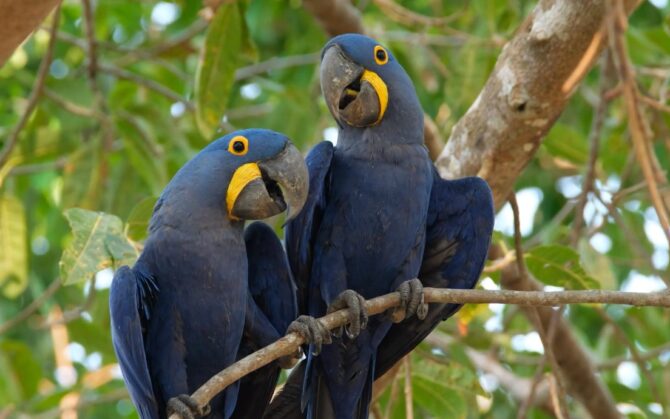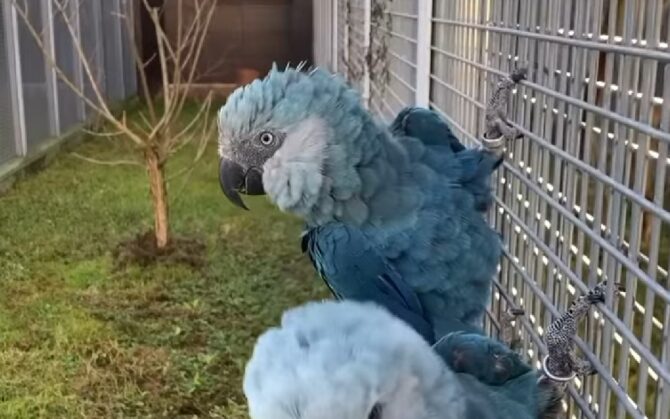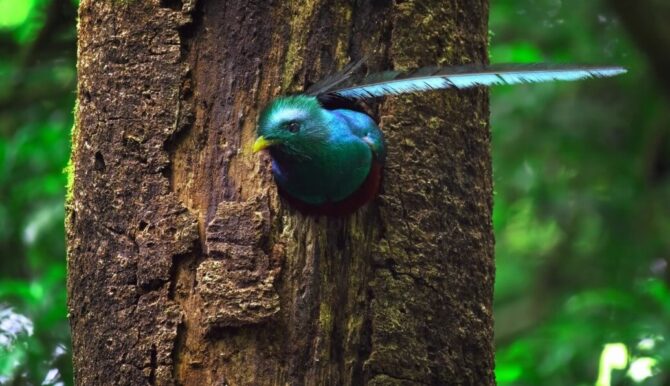The Blue Macaw, scientifically known as Spix’s macaw (Cyanopsitta spixii), is a captivating bird that has captured the attention of many due to its vibrant blue color and its status in the wild. Here’s an educational dive into the world of this beautiful bird.
History

Spix’s macaw, colloquially known as the little blue macaw, is a bird that has a rich history intertwined with human discovery and exploration. Native to the vast landscapes of Brazil, its existence has been known to the western world since the 17th century. As of 2024, The Spix macaw is now extinct in the wild but they continue to exist in captivity.
The first documented description of this bird was made by the German naturalist Georg Marcgrave in 1638. Marcgrave’s work in the field of natural history was pioneering for its time, and his documentation of the Spix’s macaw is a testament to his meticulous observations. His records provided the first glimpse of this bird to the European scientific community.
However, it wasn’t until almost two centuries later, in 1819, that another German naturalist, Johann Baptist von Spix, collected a specimen during his travels in Brazil. This specimen would later play a pivotal role in the scientific classification of the bird. In honor of his contributions and the specimen he provided, the bird was named after him.
The 20th century, however, brought about significant changes to the bird’s natural habitat. Rapid industrialization, urbanization, and deforestation in Brazil led to a drastic reduction in the bird’s natural habitat. This, coupled with illegal trapping for the pet trade, led to a rapid decline in their numbers. By the end of the century, the Spix’s macaw had vanished from the wild.
The International Union for Conservation of Nature (IUCN) took note of this tragic development and officially declared the Spix’s macaw extinct in the wild in 2019.
Physical Appearance

This bird is a visual delight, a true embodiment of nature’s artistry. As a medium-sized parrot, it weighs in at approximately 300 grams, making it a lightweight in the world of parrots. But what it lacks in size, it more than makes up for in its vibrant coloration.
The bird’s entire body is a canvas painted in various shades of blue. Starting from its head, which is a subtle grey-blue, the color gradually intensifies as one moves downwards. The underparts of the bird are a soft, pastel-like light blue, which contrasts beautifully with the vivid blue of its upperparts. This gradient of blue gives the bird a unique and mesmerizing appearance.
When it comes to differentiating between males and females, the task can be quite challenging. Both genders share an almost identical appearance, making it difficult for even seasoned birdwatchers to tell them apart. However, upon closer observation, one might notice that females are slightly smaller in size compared to their male counterparts. This subtle difference in size is one of the few distinguishing features between the two genders.
Natural Habitat

The creature of vibrant hues and captivating beauty, once thrived in the unique ecosystems of northeastern Brazil. The bird’s chosen habitat was the riparian Caraibeira woodland galleries. These galleries, often described as linear oases, are forested corridors that line the banks of freshwater systems. In the case of the Spix’s macaw, it was the drainage basin of the Rio São Francisco, one of Brazil’s most significant river systems, that provided this habitat.
Interestingly, while the Spix’s macaw is known for its vibrant blue hue and unique habitat, there are other birds that have adapted to thrive in challenging environments, such as the highest flying birds in the world.
The Caatinga, a biome exclusive to Brazil, paints a picture of stark contrasts. While it is primarily characterized by its dry forest climate, the presence of the Rio São Francisco and its tributaries creates pockets of lush riparian zones within this arid landscape. It was in these zones that the Spix’s macaw found its sanctuary.
Central to the Spix’s macaw’s survival was the Caraibeira tree (Tabebuia aurea). This tree wasn’t just a part of the landscape; it was integral to the bird’s life cycle. The Spix’s macaw built its nests in the hollows of mature Caraibeira trees, foraged its seeds for sustenance, and sought refuge in its branches during the twilight hours. Such a heavy reliance on a single tree species underscores the specialized nature of the bird’s habitat requirements.
However, the 20th century was not kind to the Spix’s macaw. As deforestation rates soared, driven by the demands of agriculture and urbanization, vast swathes of the Caatinga were cleared. Given the bird’s specialized habitat and its limited geographical range, these changes were catastrophic. As their homes disappeared, the Spix’s macaw became an increasingly rare sight in the wild, a poignant reminder of the fragility of nature.
Dietary Preferences

While primarily a herbivore, the macaw had a varied and diverse diet that reflected the flora of the Caatinga. Seeds and nuts were the mainstay of its diet. The bird’s strong beak, evolved over millennia, was perfectly adapted to crack open the hard shells of nuts to access the nutritious kernels within.
The seeds of the Caraibeira tree, given the bird’s close association with it, were a dietary staple. But the Spix’s macaw was not a fussy eater. The Caatinga, despite its dry and arid reputation, is home to a plethora of plant species. Among these, the shrubs of the Euphorbiaceae family were particularly favored by the Spix’s macaw. This family of plants, known for its hardy nature and ability to thrive in the Caatinga’s challenging conditions, provided a consistent and reliable food source for the bird.
The dominance of the Caraibeira and Euphorbiaceae in the bird’s diet is a testament to its adaptability. In a region where resources can be scarce, the Spix’s macaw had evolved to optimize its dietary habits, ensuring its survival in the challenging landscapes of the Caatinga.
Reproduction
The Spix’s, like many species, has a unique and intricate reproductive process. In captivity, these birds reach their sexual maturity at approximately seven years of age. This is the point at which they are biologically ready to mate and produce offspring. However, the real magic of their reproductive behavior is best observed in the wild.
Wild macaws engage in elaborate courtship rituals that are both fascinating and endearing. Mutual feeding, where the birds share food with each other, is a common practice. This act not only strengthens the bond between the pair but also showcases the ability of a potential mate to provide for the family. Another captivating ritual is synchronized flying. This aerial dance, where the birds mirror each other’s movements in the sky, is a testament to their deep connection and compatibility.
When it comes to nesting, the Spix’s macaw showcases a strong preference for the hollows of mature Caraibeira trees. These hollows provide a safe and sheltered environment for the birds to lay their eggs and rear their young. Remarkably, these macaws often return to the same nesting site year after year, a behavior that highlights their deep connection to their habitat.
Decline and Extinction

The story of the this bird is a poignant one, marked by wonder, loss, and hope. When the bird was first discovered in 1819, it was already a rarity in the wild. Over the subsequent decades, a combination of factors accelerated its decline.
Hunting, primarily for the pet trade, took a significant toll on the population. Trapping, often done illegally, further reduced their numbers. Deforestation, driven by the demands of a growing human population, robbed the Spix’s macaw of its natural habitat. To add to these challenges, the introduction of invasive species disrupted the delicate ecological balance of the Caatinga, further endangering the bird.
By the dawn of the 1980s, the situation was dire. The Spix’s macaw was believed to have vanished from the wild. This belief seemed to be confirmed when the last known wild male disappeared in 2000. However, nature is full of surprises. In 2016, there were whispers of potential sightings, reigniting hope for the species.
Conservation Efforts
Recognizing the critical status of the Spix’s macaw, conservationists in the 1980s began to champion the cause of saving this species. The focus was on captive breeding, a strategy that aimed to increase the bird’s numbers in a controlled environment.
By 1990, the results of these efforts were becoming evident. While only 15 captive Spix’s macaws were known to exist, there was also a glimmer of hope with the presence of one in the wild. The subsequent decades saw intensified conservation efforts.
A significant milestone was reached in June 2022. A flock of eight Spix’s macaws, raised in captivity, was released back into their natural habitat. This was followed by another release in December of the same year, where twelve more birds took to the skies of the Caatinga. These releases are a testament to the dedication of conservationists and offer hope for the future of the Spix’s macaw.
FAQs
What is the Spix’s macaw also known as?
The Spix’s macaw is colloquially referred to as the “little blue macaw” due to its vibrant blue plumage.
Where was the macaw’s natural habitat?
The Spix’s macaw was native to the riparian Caraibeira woodland galleries in the drainage basin of the Rio São Francisco, situated within the Caatinga dry forest climate of northeastern Brazil.
Why was the Caraibeira tree significant to these majestic birds?
The Caraibeira tree played a pivotal role in the life of the Spix’s macaw. The bird relied heavily on this tree for nesting, feeding, and roosting, showcasing a deep ecological interdependence.
When was the last known sighting of a wild Spix’s macaw?
The last confirmed wild male Spix’s macaw was seen in 2000. However, there were unconfirmed reports of potential sightings in 2016, reigniting hope for the species.
What led to the declinein the wild?
Several factors contributed to the decline of the Spix’s macaw, including hunting, illegal trapping for the pet trade, deforestation, and the introduction of invasive species that disrupted their natural habitat.
How are conservationists working to revive macaw’s population?
Conservationists initiated a captive breeding program in the 1980s to increase the bird’s numbers. As of 2022, efforts have been made to reintroduce the Spix’s macaw to the wild, with a flock of eight released in June and another twelve in December.
Conclusion
In conclusion, while the Spix’s macaw may be extinct in the wild, efforts are being made to reintroduce and conserve this beautiful species. The story of the Spix’s macaw serves as a reminder of the importance of conservation and the delicate balance of nature.






